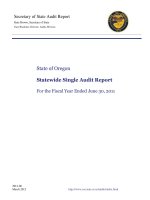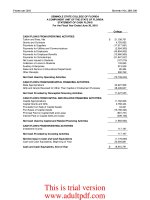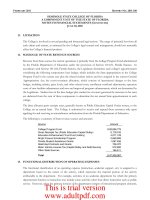REPORT NO. 2011-108 FEBRUARY 2011 SEMINOLE STATE COLLEGE OF FLORIDA Financial Audit For the Fiscal Year Ended June 30, 2010_part4 docx
Bạn đang xem bản rút gọn của tài liệu. Xem và tải ngay bản đầy đủ của tài liệu tại đây (141.42 KB, 10 trang )
FEBRUARY 2011 REPORT NO. 2011-108
SEMINOLE STATE COLLEGE OF FLORIDA
A COMPONENT UNIT OF THE STATE OF FLORIDA
NOTES
TO FINANCIAL STATEMENTS (CONTINUED)
J
UNE 30, 2010
27
Other Postemployment Benefits Payable
. The College follows Governmental Accounting Standards
Board Statement No. 45, Accounting and Financial Reporting by Employers for Postemployment Benefits Other Than
Pensions, for certain other postemployment benefits administered by the Florida College System Risk
Management Consortium (Consortium) and life insurance benefits through purchased commercial
insurance.
Plan Description. The College contributes to an agent, multiple-employer defined-benefit plan administered
by the Consortium for postemployment healthcare benefits and has a single-employer defined benefit plan
for life insurance benefits. Pursuant to the provisions of Section 112.0801, Florida Statutes, former
employees who retire from the College are eligible to participate in the College’s healthcare and life
insurance benefits. The College subsidizes the premium rates paid by retirees by allowing them to
participate in the plans at reduced or blended group (implicitly subsidized) premium rates for both active and
retired employees. These rates provide an implicit subsidy for retirees because, on an actuarial basis, their
current and future claims are expected to result in higher costs to the plans on average than those of active
employees. The College does not offer any explicit subsidies for retiree coverage. Retirees are required to
enroll in the Federal Medicare program for their primary health coverage as soon as they are eligible.
Neither the College nor the Consortium issue a stand-alone annual report for the plans and they are not
included in the annual report of a public employee retirement system or another entity.
Funding Policy. Plan benefits are pursuant to the provisions of Section 112.0801, Florida Statutes, and the
Board of Trustees can amend the benefits and contribution rates. The College has not advance-funded or
established a funding methodology for the annual other postemployment benefit (OPEB) costs or the net
OPEB obligation, and the plans are financed on a pay-as-you-go basis. For the 2009-10 fiscal year,
85 retirees received postemployment healthcare benefits, and 28 retirees received postemployment life
insurance benefits. The College provided required contributions of $79,727 toward the annual OPEB cost,
comprised of benefit payments made on behalf of retirees for claim expenses (net of reinsurance),
administrative expenses, and reinsurance premiums. Retiree contributions totaled $533,349.
Annual OPEB Cost and Net OPEB Obligation. The College’s annual OPEB cost (expense) is calculated based
on the annual required contribution (ARC), an amount actuarially determined in accordance with the
parameters of Governmental Accounting Standards Board Statement No. 45. The ARC represents a level of
funding that if paid on an ongoing basis, is projected to cover normal cost each year and amortize any
unfunded actuarial liabilities over a period not to exceed 30 years. The following table shows the College’s
annual OPEB cost for the year, the amount actually contributed to the plans, and changes in the College’s
net OPEB obligation:
This is trial version
www.adultpdf.com
FEBRUARY 2011 REPORT NO. 2011-108
SEMINOLE STATE COLLEGE OF FLORIDA
A COMPONENT UNIT OF THE STATE OF FLORIDA
NOTES
TO FINANCIAL STATEMENTS (CONTINUED)
J
UNE 30, 2010
28
Description Amount
Normal Cost (Service Cost for One Year) 67,961$
Amortization of Unfunded Actuarial
Accrued Liability 28,222
Annual Required Contribution
96,183
Interest on Net OPEB Obligation 1,141
Adjustment to Annual Required Contribution (1,268)
Annual OPEB Cost (Expense)
96,056
Contribution Toward the OPEB Cost (79,727)
Increase in Net OPEB Obligation
16,329
Net OPEB Obligation, Beginning of Year 38,022
Net OPEB Obligation, End of Year
54,351$
The College’s annual OPEB cost, the percentage of annual OPEB cost contributed to the plans, and the net
OPEB obligation as of June 30, 2010, and for the transition and preceding years, were as follows:
Fiscal Year Annual Percentage of Net OPEB
OPEB Cost Annual Obligation
OPEB Cost
Contributed
Beginning Balance, July 1, 2007 $ $
2007-08 86,970 77.4% 19,616
2008-09 86,905 78.8% 38,022
2009-10 96,056 83.0% 54,351
Funded Status and Funding Progress. As of July 1, 2009, the most recent valuation date, the actuarial accrued
liability for benefits was $822,803 and the actuarial value of assets was $0, resulting in an unfunded actuarial
accrued liability of $822,803 and a funded ratio of 0 percent. The covered payroll (annual payroll of active
participating employees) was $34,652,305 for the 2009-10 fiscal year, and the ratio of the unfunded actuarial
accrued liability to the covered payroll was 2.4 percent.
Actuarial valuations of an ongoing plan involve estimates of the value of reported amounts and assumptions
about the probability of occurrence of events far into the future. Examples include assumptions about
future employment and termination, mortality, and healthcare cost trends. Amounts determined regarding
the funded status of the plan and the annual required contributions of the employer are subject to continual
revision as actual results are compared with past expectations and new estimates are made about the future.
The Schedule of Funding Progress, presented as required supplementary information following the notes to
financial statements, presents multiyear trend information that shows whether the actuarial value of plan
assets is increasing or decreasing over time relative to the actuarial accrued liabilities for benefits.
This is trial version
www.adultpdf.com
FEBRUARY 2011 REPORT NO. 2011-108
SEMINOLE STATE COLLEGE OF FLORIDA
A COMPONENT UNIT OF THE STATE OF FLORIDA
NOTES
TO FINANCIAL STATEMENTS (CONTINUED)
J
UNE 30, 2010
29
Actuarial Methods and Assumptions. Projections of benefits for financial reporting purposes are based on the
substantive plan provisions, as understood by the employer and participating members, and include the types
of benefits provided at the time of each valuation and the historical pattern of sharing of benefit costs
between the employer and participating members. The actuarial methods and assumptions used include
techniques that are designed to reduce the effects of short-term volatility in actuarial accrued liabilities and
the actuarial value of assets, consistent with the long-term perspective of the calculations.
The College’s OPEB actuarial valuation as of July 1, 2009, used the projected unit credit actuarial method to
estimate the unfunded actuarial liability as of June 30, 2010, and the College’s 2009-10 fiscal year ARC. This
method was selected because it is the same method used in the private sector for determination of retiree
medical liabilities. Because the OPEB liability is currently unfunded, the actuarial assumptions included a
3 percent rate of return on invested assets, which is the College’s expectation of investment returns. The
actuarial assumptions also included a payroll growth rate of 3 percent per year, and an annual healthcare cost
trend rate of 7.8 percent for the 2009-10 fiscal year, reduced by 0.2 percent per year for two years, then
0.1 to 0.3 percent thereafter, to an ultimate rate of 4.5 percent after seventeen years. The unfunded actuarial
accrued liability is being amortized as a level percentage of projected payroll over 30 years. The remaining
amortization period at June 30, 2010, was 27 years.
9. RETIREMENT PROGRAMS
Florida Retirement System
. Essentially all regular employees of the College are eligible to enroll as
members of the State-administered Florida Retirement System (FRS). Provisions relating to FRS are
established by Chapters 121 and 122, Florida Statutes; Chapter 112, Part IV, Florida Statutes; Chapter 238,
Florida Statutes; and Florida Retirement System Rules, Chapter 60S, Florida Administrative Code; wherein
eligibility, contributions, and benefits are defined and described in detail. FRS is a single retirement system
administered by the Department of Management Services, Division of Retirement, and consists of two
cost-sharing, multiple-employer retirement plans and other nonintegrated programs. These include a
defined-benefit pension plan (Plan), a Deferred Retirement Option Program (DROP), and a
defined-contribution plan, referred to as the Public Employee Optional Retirement Program (PEORP).
Employees in the Plan vest at six years of service. All vested members are eligible for normal retirement
benefits at age 62 or at any age after 30 years of service, which may include up to 4 years of credit for
military service. The Plan also includes an early retirement provision; however, there is a benefit reduction
for each year a member retires before his or her normal retirement date. The Plan provides retirement,
disability and death benefits, and annual cost-of-living adjustments.
DROP, subject to provisions of Section 121.091, Florida Statutes, permits employees eligible for normal
retirement under the Plan to defer receipt of monthly benefit payments while continuing employment with
an FRS employer. An employee may participate in DROP for a period not to exceed 60 months after
electing to participate. During the period of DROP participation, deferred monthly benefits are held in the
FRS Trust Fund and accrue interest.
This is trial version
www.adultpdf.com
FEBRUARY 2011 REPORT NO. 2011-108
SEMINOLE STATE COLLEGE OF FLORIDA
A COMPONENT UNIT OF THE STATE OF FLORIDA
NOTES
TO FINANCIAL STATEMENTS (CONTINUED)
J
UNE 30, 2010
30
The State of Florida establishes contribution rates for participating employers. Contribution rates during the
2009-10 fiscal year were as follows:
Class Percent of Gross Salary
Employee Employer
(A)
Florida Retirement System, Regular 0.00 9.85
Florida Retirement System, Senior Management Service 0.00 13.12
Deferred Retirement Option Program - Applicable to
Members from All of the Above Classes 0.00 10.91
Florida Retirement System, Reemployed Retiree (B) (B)
Notes: (A)
(B)
Employer rates include 1.11 percent for the postemployment health
insurance subsidy. Also, employer rates, other than for DROP
participants, include 0.05 percent for administrative costs of the Public
Employee Optional Retirement Program.
Contribution rates are dependent upon retirement class in which
reemployed.
The College’s liability for participation is limited to the payment of the required contribution at the rates and
frequencies established by law on future payrolls of the College. The College’s contributions for the fiscal
years ended June 30, 2008, June 30, 2009, and June 30, 2010, totaled $2,334,220, $2,465,460, and $2,578,287,
respectively, which were equal to the required contributions for each fiscal year.
As provided in Section 121.4501, Florida Statutes, eligible FRS members may elect to participate in the
PEORP in lieu of the FRS defined-benefit plan. College employees already participating in the State College
System Optional Retirement Program or the DROP are not eligible to participate in this program.
Employer contributions are defined by law, but the ultimate benefit depends in part on the performance of
investment funds. The PEORP is funded by employer contributions that are based on salary and
membership class (Regular Class, Senior Management Service Class, etc.). Contributions are directed to
individual member accounts, and the individual members allocate contributions and account balances among
various approved investment choices. Employees in PEORP vest at one year of service. There were
115 College participants during the 2009-10 fiscal year. Required contributions made to the PEORP totaled
$513,683.
Financial statements and other supplementary information of the FRS are included in the State’s
Comprehensive Annual Financial Report, which is available from the Florida Department of Financial
Services. An annual report on the FRS, which includes its financial statements, required supplementary
information, actuarial report, and other relevant information, is available from the Florida Department of
Management Services, Division of Retirement.
State College System Optional Retirement Program
. Section 1012.875, Florida Statutes, provides for an
Optional Retirement Program (Program) for eligible college instructors and administrators. The Program is
designed to aid colleges in recruiting employees by offering more portability to employees not expected to
remain in the FRS for six or more years.
This is trial version
www.adultpdf.com
FEBRUARY 2011 REPORT NO. 2011-108
SEMINOLE STATE COLLEGE OF FLORIDA
A COMPONENT UNIT OF THE STATE OF FLORIDA
NOTES
TO FINANCIAL STATEMENTS (CONTINUED)
J
UNE 30, 2010
31
The Program is a defined-contribution plan, which provides full and immediate vesting of all contributions
submitted to the participating companies on behalf of the participant. Employees in eligible positions can
make an irrevocable election to participate in the Program, rather than the FRS, and purchase retirement and
death benefits through contracts provided by certain insurance carriers. The employing college contributes,
on behalf of the participant, 10.43 percent of the participant’s salary, less a small amount used to cover
administrative costs. The remaining contribution is invested in the company or companies selected by the
participant to create a fund for the purchase of annuities at retirement. The participant may contribute, by
payroll deduction, an amount not to exceed the percentage contributed by the college to the participant’s
annuity account.
There were 81 College participants during the 2009-10 fiscal year. Required employer contributions made to
the Program totaled $577,336.
Senior Management Service Class Local Annuity Program
. Section 121.055, Florida Statutes, and
Florida Retirement System Rule 60S-1.0057, Florida Administrative Code, provide that local agency
employees eligible for the FRS, Senior Management Service Class, may elect to withdraw from the FRS
altogether and participate in a lifetime monthly annuity program offered by the local agency. Pursuant
thereto, the College, during the 1997-98 fiscal year established a Senior Management Service Class Local
Annuity Program. Employees in eligible positions are allowed to make an irrevocable election to participate
in the program, rather than in the FRS. Under the Program, the College contributes the same percentage of
the participant’s salary as would have been contributed to the FRS, Senior Management Service Class,
toward an annuity provided by approved fund sponsors. The participant does not make contributions to the
Plan. As of June 30, 2010 one College employee had opted to participate in the Program. Contributions
made by the College to the Program totaled $12,516 during the 2009-10 fiscal year.
10. CONSTRUCTION COMMITMENTS
The College’s major construction commitments at June 30, 2010, are as follows:
Project Description Total Completed Balance
Committed to Date Committed
L and F Buildings Renovation:
Architect 1,035,923$ 808,520$ 227,403$
Student Services Building:
Architect 250,000 24,000 226,000
Sanford/Lake Mary Campus Signage:
Construction 608,863 608,863
Total
1,894,786$ 832,520$ 1,062,266$
11. OPERATING LEASE COMMITMENTS
Leased assets and the related commitments are not reported on the College’s statement of net assets.
Operating lease payments are recorded as expenses when paid or incurred. Outstanding commitments
This is trial version
www.adultpdf.com
FEBRUARY 2011 REPORT NO. 2011-108
SEMINOLE STATE COLLEGE OF FLORIDA
A COMPONENT UNIT OF THE STATE OF FLORIDA
NOTES
TO FINANCIAL STATEMENTS (CONTINUED)
J
UNE 30, 2010
32
resulting from these lease agreements are contingent upon future appropriations. The College has the
following operating lease commitments:
Land utilized for a Public Safety Training Center is leased under an operating lease that expires in
2052. Annual lease payments total $11,146 and continue until 2023; thereafter, payments are reduced
to $1 annually until the expiration of the lease term.
Computers and related equipment are leased under operating leases. These leases are for three and
four years and the equipment is returned to the lessor upon expiration of the lease.
College vehicles, primarily used by the maintenance department and security department, are leased
for five years under an operating lease that began in fiscal year 2008-09.
Future minimum lease commitments for noncancelable operating leases are as follows:
Fiscal Year Ending June 30 Amount
2011 919,072$
2012 697,640
2013 340,964
2014 152,907
2015 16,837
2016-2020 55,730
2021-2023 33,440
Total Minimum Payments Required
2,216,590$
12. RISK MANAGEMENT PROGRAMS
The College is exposed to various risks of loss related to torts; theft of, damage to, and destruction of assets;
errors and omissions; injuries to employees; and natural disasters. The College provided coverage for these
risks primarily through the Florida College System Risk Management Consortium (Consortium), which was
created under authority of Section 1001.64(27), Florida Statutes, by the boards of trustees of the Florida
public colleges for the purpose of joining a cooperative effort to develop, implement, and participate in a
coordinated Statewide College risk management program. The Consortium is self-sustaining through
member assessments (premiums) and is reinsured through commercial companies for claims in excess of
specified amounts. Reinsurance from commercial companies provided excess coverage of up to
$175 million through February 28, 2010, and $150 million effective March 1, 2010. Insurance coverage
obtained through the Consortium included health, fire and extended property, general and automobile
liability, workers’ compensation, and other liability coverage. Settled claims resulting from these risks have
not exceeded coverage in any of the past three fiscal years.
Life insurance coverage is provided through purchased commercial insurance.
This is trial version
www.adultpdf.com
FEBRUARY 2011 REPORT NO. 2011-108
SEMINOLE STATE COLLEGE OF FLORIDA
A COMPONENT UNIT OF THE STATE OF FLORIDA
NOTES
TO FINANCIAL STATEMENTS (CONTINUED)
J
UNE 30, 2010
33
13. LITIGATION
The College is involved in several pending and threatened legal actions. The range of potential loss from all
such claims and actions, as estimated by the College’s legal counsel and management, should not materially
affect the College’s financial position.
14. SCHEDULE OF STATE REVENUE SOURCES
Revenue from State sources for current operations is primarily from the College Program Fund administered
by the Florida Department of Education under the provisions of Section 1011.81, Florida Statutes. In
accordance with Section 1011.84, Florida Statutes, the Legislature determines each college’s apportionment
considering the following components: base budget, which includes the State appropriation to the College
Program Fund in the current year plus the related student tuition and fees assigned in the current General
Appropriations Act; the cost-to-continue allocation, which consists of incremental changes to the base
budget, including salaries, price levels, and other related costs; enrollment workload adjustments; operation
costs of new facilities adjustments; and new and improved program enhancements, which are determined by
the Legislature. Student fees in the base budget plus student fee revenues generated by increases in fee rates
are deducted from the sum of these components to determine the net annual State apportionment to each
college.
The State allocates gross receipts taxes, generally known as Public Education Capital Outlay money, to the
College on an annual basis. The College is authorized to receive and expend these resources only upon
applying for and receiving an encumbrance authorization from the Florida Department of Education.
The following is a summary of State revenue sources and amounts:
Source Amount
College Program Fund 28,856,779$
Gross Receipts Tax (Public Education Capital Outlay) 9,178,016
4,071,129
Bright Futures Scholarship Program 2,669,826
Florida Student Assistance Grants 1,087,456
Restricted Contracts and Grants 706,370
Motor Vehicle License Tax (Capital Outlay and Debt Service) 572,800
Other State Sources 166,611
Total
47,308,987$
Education Enhancement Trust Fund (Lottery)
15. FUNCTIONAL DISTRIBUTION OF OPERATING EXPENSES
The functional classification of an operating expense (instruction, academic support, etc.) is assigned to a
department based on the nature of the activity, which represents the material portion of the activity
attributable to the department. For example, activities of an academic department for which the primary
departmental function is instruction may include some activities other than direct instruction such as public
service. However, when the primary mission of the department consists of instructional program elements,
This is trial version
www.adultpdf.com
FEBRUARY 2011 REPORT NO. 2011-108
SEMINOLE STATE COLLEGE OF FLORIDA
A COMPONENT UNIT OF THE STATE OF FLORIDA
NOTES
TO FINANCIAL STATEMENTS (CONTINUED)
J
UNE 30, 2010
34
all expenses of the department are reported under the instruction classification. The operating expenses on
the statement of revenues, expenses, and changes in net assets are presented by natural classifications. The
following are those same expenses presented in functional classifications as recommended by NACUBO:
Functional Classification Amount
Instruction 33,889,940$
Academic Support 6,828,299
Student Services 9,262,415
Institutional Support 11,946,301
Operation and Maintenance of Plant 14,271,672
Scholarships and Fellowships 21,847,246
Depreciation 6,647,279
Auxiliary Enterprises 596,868
Total Operating Expenses
105,290,020$
16. CURRENT UNRESTRICTED FUNDS
The Southern Association of Colleges and Schools, Commission on Colleges, which establishes the
accreditation requirements for institutions of higher education, requires a disclosure of the financial position
of unrestricted net assets, exclusive of plant assets and plant-related debt, which represents the change in
unrestricted net assets. To meet this requirement, statements of net assets and revenues, expenses, and
changes in net assets for the current unrestricted funds are presented, as follows:
This is trial version
www.adultpdf.com
FEBRUARY 2011 REPORT NO. 2011-108
SEMINOLE STATE COLLEGE OF FLORIDA
A COMPONENT UNIT OF THE STATE OF FLORIDA
NOTES
TO FINANCIAL STATEMENTS (CONTINUED)
J
UNE 30, 2010
35
ASSETS
Current Assets:
Cash and Cash Equivalents 10,834,128$
Accounts Receivable, Net 3,177,361
Due from Other Governmental Agencies 393,106
Due from Component Unit 49,797
Prepaid Expenses 723,715
TOTAL ASSETS
15,178,107$
LIABILITIES
Current Liabilities:
Accounts Payable 744,067$
Salary and Payroll Taxes Payable 1,017,642
Deferred Revenue 7,573
Deposits Held for Others 117,887
Compensated Absences Payable 122,617
Total Current Liabilities
2,009,786
Noncurrent Liabilities:
Compensated Absences Payable 4,912,448
Other Postemployment Benefits Payable 54,351
Total Noncurrent Liabilities
4,966,799
TOTAL LIABILITIES
6,976,585
TOTAL NET ASSETS
8,201,522
TOTAL LIABILITIES AND NET ASSETS
15,178,107$
Statement of Current Unrestricted Funds Net Assets
This is trial version
www.adultpdf.com
FEBRUARY 2011 REPORT NO. 2011-108
SEMINOLE STATE COLLEGE OF FLORIDA
A COMPONENT UNIT OF THE STATE OF FLORIDA
NOTES
TO FINANCIAL STATEMENTS (CONTINUED)
J
UNE 30, 2010
36
REVENUES
Operating Revenues:
Student Tuition and Fees, Net of Scholarship
Allowances of $15,046,562 17,815,697$
Federal Grants and Contracts 105,343
State and Local Grants and Contracts 149,488
Nongovernmental Grants and Contracts 603,762
Sales and Services of Educational Departments 16,507
Auxiliary Enterprises 1,403,808
Other Operating Revenues 151,699
Total Operating Revenues
20,246,304
EXPENSES
Operating Expenses:
Personnel Services 53,485,496
Scholarships and Waivers 603
Utilities and Communications 2,547,756
Contractual Services 2,035,655
Other Services and Expenses 4,586,125
Materials and Supplies 2,755,436
Total Operating Expenses
65,411,071
Operating Loss
(45,164,767)
NONOPERATING REVENUES
State Appropriations 32,927,908
Gifts and Grants 2,874,753
Investment Income 42,411
Other Nonoperating Revenues 21,853
Net Nonoperating Revenues
35,866,925
Loss Before Other Revenues,
Expenses, Gains, or Losses
(9,297,842)
Transfers from Other Funds 14,462,588
Increase in Net Assets
5,164,746
Net Assets, Beginning of Year 3,036,776
Net Assets, End of Year
8,201,522$
Statement of Current Unrestricted Funds Revenues,
Ex
p
enses, and Chan
g
es in Net Assets
17. SUBSEQUENT EVENTS
During the 2010 legislative session, the College received Public Education Capital Outlay funds for the
purchase of 25 acres of land adjacent to the existing Altamonte Springs campus. This land includes three
existing buildings of over 90,000 square feet. On July 29, 2010, the College closed on this purchase at a cost
This is trial version
www.adultpdf.com









